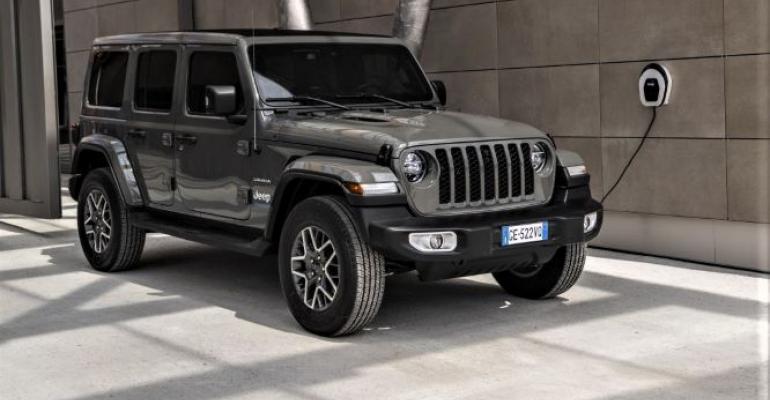If you had a magic wand, it would be great to rid the auto industry of supply-chain inventory delays, consumer worries about inflation, gas prices, higher interest rates and global economic crises – all elements influencing the U.S. initiative to move drivers out of fuel-powered vehicles to electric vehicles.
But we live in the harsh reality of all these influences. One interim solution that can help continue the momentum toward EVs is the plug-in hybrid EV (PHEV) model. Avoiding some of the sticker shock of full EVs, these models can lessen dependency on gasoline, save the customer money by using less gasoline and nurture the eventual transition to EVs.
Edmunds, in a March announcement, notes PHEVs and hybrids “might be more widely available than EVs right now, which could be a nice compromise for consumers.” Another potential advantage for drivers is that some of the best-rated PHEVs currently offer more affordable price points. The Toyota RAV4 Prime (MSRP $39,800-$43,125) is one example. For a little higher price, a driver can enter the luxury PHEV class with a ’22 Volvo S60 Recharge (MSRP $39,250-$64,800) (pictured, below) that offers three PHEV models.

In contrast, EV prices were averaging about $60,000, but lower-priced, more competitive models are due on the market over the next year.
Portable Charging
Given that PHEVs are designed to use either batteries or gasoline, consumers wary of gas prices might wonder if PHEVs are the route to take, rather than wait for EVs to be more available. Portable wall chargers offer PHEV drivers, and in the long term, EV drivers, an efficient way of charging vehicle batteries. Drivers can plug in the portable charger at their home outlet and charge their battery overnight.
In the case of PHEVs, drivers usually can spend a typical workday without using gasoline power. EV drivers have significant advantages by being able to plug in their portable chargers at home, at work or at hotels or public charging stations on the road. The portable chargers make longer-distance EV driving a reality.
Portable wall chargers use regular AC current at a regular 120V outlet (Level 1 charging) or a 240V outlet (Level 2 charging). Charging on a 240V outlet should be about seven times faster than the 120 V outlet. Battery size is another factor. While EVs have a battery size starting at about 50 kW, PHEV have batteries about one-third that size, usually between 16- 19-kW. This means the battery of a PHEV will recharge from 0%-80% (industry standard) in about 10 hours using Level 1 and 1.5 hours using Level 2. However, range is limited compared to an EV.
The best portable chargers will be waterproof, dustproof and rugged enough to withstand harsh environments, important factors for business and recreational travelers. Chargers with interchangeable adapters, and the ability to easily switch charging power, will be useful when traveling.
Driving Business
Delivery wait time for EVs, according to Edmunds, ranges from 20-28 weeks for the Ford Mustang Mach-E to October 2022-January 2023 for the Tesla Model X. Pre-orders also are taking a long time to fulfill. From a dealer’s point of view, selling any available PHEVs, given the continuing inventory lag and consumers’ increased interest in getting rid of gasoline-powered vehicles, is a good interim solution to continue customer and sales engagement until more EVs are available.
 Despite the unsettled world stage – the pandemic, political strife – the U.S. consumer has shown undaunted optimism in embracing an electric-vehicle and hybrid future. According to BloombergNEF and the Business Council for Sustainable Energy, U.S. EV sales in 2021 totaled 657,000, twice the 325,000 units sold in 2020. Battery-electric vehicles comprised 75% of 2021 sales, while PHEVs made up close to the remaining 25%. Fuel-cell electric vehicles remain a small part of the overall market with 3,341 units being sold in 2021.
Despite the unsettled world stage – the pandemic, political strife – the U.S. consumer has shown undaunted optimism in embracing an electric-vehicle and hybrid future. According to BloombergNEF and the Business Council for Sustainable Energy, U.S. EV sales in 2021 totaled 657,000, twice the 325,000 units sold in 2020. Battery-electric vehicles comprised 75% of 2021 sales, while PHEVs made up close to the remaining 25%. Fuel-cell electric vehicles remain a small part of the overall market with 3,341 units being sold in 2021.
Overall, the U.S. is moving in the right direction in EV adoption. Since we know about 164,250 PHEVs sold last year, the best strategy is to leverage this interest and continue selling PHEVs in 2022 while phasing in more EVs as they become available. Long term there likely will continue to be a mix of electric, hybrid and PHEVs until the EV market is fully populated with models and supply-chain hurdles are eliminated.
Christoph Erni (pictured, above left) is founder and CEO of Juice Technology, a Switzerland-based producer of mobile 22-kW electrical charging stations.





